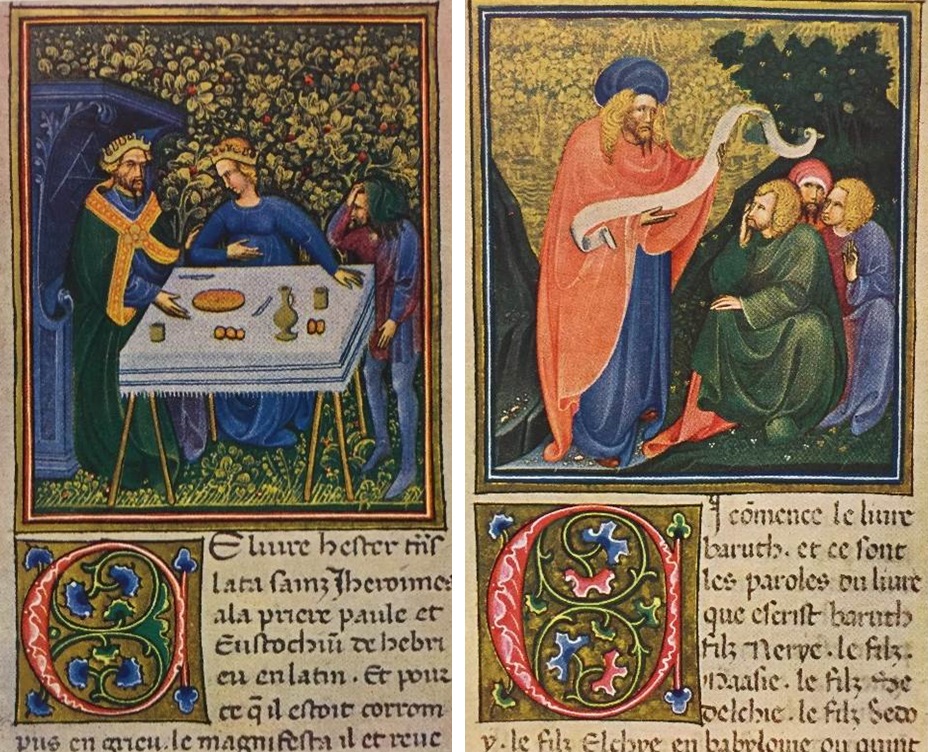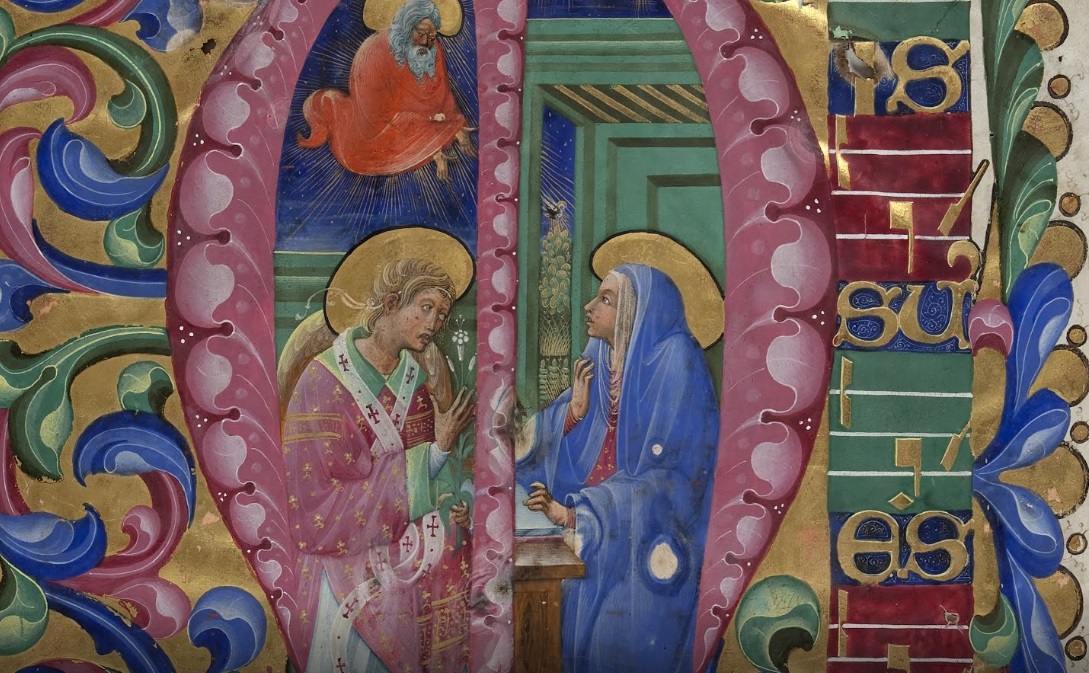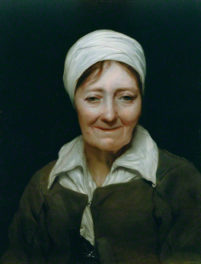
Initial A: Young Christ Blessing (detail) from Antiphonal P of San Giorgio Maggiore, Belbello da Pavia, about 1467–70. The J. Paul Getty Museum, Ms. 96, verso
During his long career, Belbello da Pavia was an itinerant court artist, a wanted criminal, an avid petitioner for new contracts, and, in his old age, a duke’s protégé sent to work for a community of monks. The ups and downs in the career of this mid-15th-century illuminator from the northern Italian region of Lombardy vividly illustrate some of the challenges and rewards of being a court artist in Renaissance Italy. A beautiful illumination by Belbello is currently on display in the exhibition Renaissance Splendors of the Northern Italian Courts, and this post explores his intriguing and well-documented life.
An Auspicious Start: Success at the Courts of Northern Italy

Giovannino dei Grassi (left) and Belbello da Pavia (right) in facsimile edition, Millard Meiss and Edith W. Kirsch, The Visconti Hours: National Library, Florence (New York: George Braziller, 1972)
Belbello likely trained as an illuminator in Milan with some of the finest Italian miniaturists, many of whom were drawn to the court by the lavish patronage of Duke Filippo Maria Visconti, ruler of Milan from 1412 to 1447, his wife Marie of Savoy, and members of their entourage. Early in his career, Belbello was commissioned by the duke and duchess to illuminate private prayer books such as the so-called Visconti Hours, which was begun by the most famous illuminator of the previous generation, Giovannino dei Grassi, and his son Salomone.
As a young man Belbello was on the rise, with few equally talented competitors in sight.

Belbello da Pavia from the Bible of Niccolò III in Sergio Samek Ludovici, Miniature di Belbello da Pavia: dalla Bibbia Vaticana e dal Messale Gonzaga di Mantova (Milan: Aldo Martello Editore, 1954).
In addition to working for the Visconti in Milan and Pavia, Belbello completed manuscripts for other leading families: the Este marquises of Ferrara and the Gonzaga marquises of Mantua. His magnificently decorated bible for Niccolò III d’Este, marquis of Ferrara (ruled 1393-1441), was the deluxe illuminated manuscript for Italian court illuminators and patrons to try to outdo. It was perhaps part of a diplomatic gift from the Duke of Milan, Filippo Maria Visconti, who had been waging wars and conquering territories in northern Italy during the early 15th century.
It is not difficult to imagine the duke sending Belbello’s illuminated Bible to Niccolò III d’Este as a token of appreciation, since only a few years earlier Niccolo had brokered peace between Milan and its enemies Florence and Venice following a major conflict.

Pentecost from Missal of Barbara Brandenburg-Gonzaga, Belbello da Pavia, 1442-65. Archivio Storico Diocesano, Mantua (Ms. s.s., fol. 209). Photo: Roberto Bini for the facsimile edition, © Il Bulino edizioni d’arte, Italy
In 1442 Gianlucido Gonzaga, fourth son of Marquis of Mantua Gianfrancesco Gonzaga (ruled 1433-44), asked Belbello for a painted missal, or book containing the readings for the Mass. According to archival records, the artist worked on this manuscript for two years before stopping for reasons unknown. He picked up the project again in 1448, but in that year his patron Gianlucido died and the commission lapsed once again. Fortunately it was adopted the following year by a new, more powerful and visually discerning client, the Marquise of Mantua Barbara of Brandenburg-Gonzaga.
Belbello must have been happy…but that feeling would be short-lived.
Problems Personal and Artistic at the Court of Mantua
The years between 1448 and 1462 were among the most fascinating of Belbello’s life. In 1449 he was in Mantua, executing miniatures for the unfinished missal requested by the Marquise Barbara of Brandenburg-Gonzaga. The very next year, though, he must have fled her court in Mantua, because he was convicted of sodomy and condemned to burn at the stake.
In 1458 he petitioned the marquise that he might continue his work on the missal he had begun 16 years before. With or without her permission, he apparently resumed illuminating the book in 1461. We know this because part of the book was sent by the marquise’s son, Francesco Gonzaga, from Milan to the marquise herself in Mantua, along with a letter stating that Belbello had been at work on the manuscript. In the same letter, Francesco promised his mother that he would order Belbello back to the court of Mantua to finish the commission.

The Crucifixion and A Priest Celebrating Mass from the Missal of Barbara Brandenburg-Gonzaga, Girolamo da Cremona (left) and Belbello da Pavia (right), 1442-65. Archivio Storico Diocesano, Mantua (Ms. s.s., fols 182v–183). Photo: Roberto Bini for the facsimile edition, © Il Bulino edizioni d’arte, Italy
What happened next is surprising. Instead of agreeing to have Belbello returned to Mantua to complete the manuscript, the marquise responded that she wished to have the missal finished by someone else, a certain “young artist from this area who illuminates very well.” For her, Belbello’s style was now outmoded, even if it had been popular in northern Italy for more than three decades. Another, younger illuminator, one who painted in a new style, should finish the job.
Poor Belbello must have been devastated. He had lost not only a major commission, but also a significant patron and her network of wealthy contacts. Worse still, Belbello probably realized that his pictorial style was no longer fashionable, a severe blow indeed in a world in which being in style could mean everything. Belbello petitioned the marquise again in 1462, offering to finish the missal gratis, but sadly his request was not answered.
The younger artist, Girolamo da Cremona, took up the brush at the recommendation of Mantua court artist Andrea Mantegna and completed the project.
Belbello’s Continuing Decline

Initial A: Young Christ Blessing (detail) from Antiphonal P of San Giorgio Maggiore, Belbello da Pavia, about 1467–70. The J. Paul Getty Museum, Ms. 96, verso
In 1462, the same year in which Belbello unsuccessfully asked permission to finish the missal for Marquise Barbara of Brandenburg, the artist made a similarly fruitless attempt to gain employment from Duchess of Milan, Bianca Maria Visconti. Perhaps the duchess, too, considered his style outdated. Fortunately, later in the decade Belbello was able to obtain work in Venice, where he illuminated choir books for the Benedictine monks of San Giorgio Maggiore.
In the above illumination, we see that Belbello was much less concerned with rendering naturalistic bodies in convincing three-dimensional space than he was with decorative patterns and expressive faces, as for instance in the subtly delineated folds in the young Christ’s robes and his engaging visage, which suggests conversation with the viewer. In the 1460s, such a decorative style was simply no longer in vogue.
Belbello’s “Retirement”

Initial M: The Annunciation (detail) in the Antiphonal P of San Giorgio Maggiore, Belbello da Pavia, about 1467–70. Fondazione Giorgio Cini, Venice (Inv. 2093)
After completing his work on the choir books in Venice in the late 1460s, Belbello returned to his hometown of Pavia, where he had spent much of his professional life receiving prominent commissions from the Milanese court.
In 1473, Duke of Milan Galeazzo Maria Sforza (ruled 1466–76) took pity on Belbello by asking the local community of Carthusian monks to adopt the painter and give him work illuminating their choir books. After this point we hear no more of Belbello, but we can imagine that after his dramatic rise and fall as a court artist, he lived a peaceful life in the monastery where he could continue his half-century-long career as a talented miniaturist.
Text of this post © Christopher W. Platts. All rights reserved.




Comments on this post are now closed.